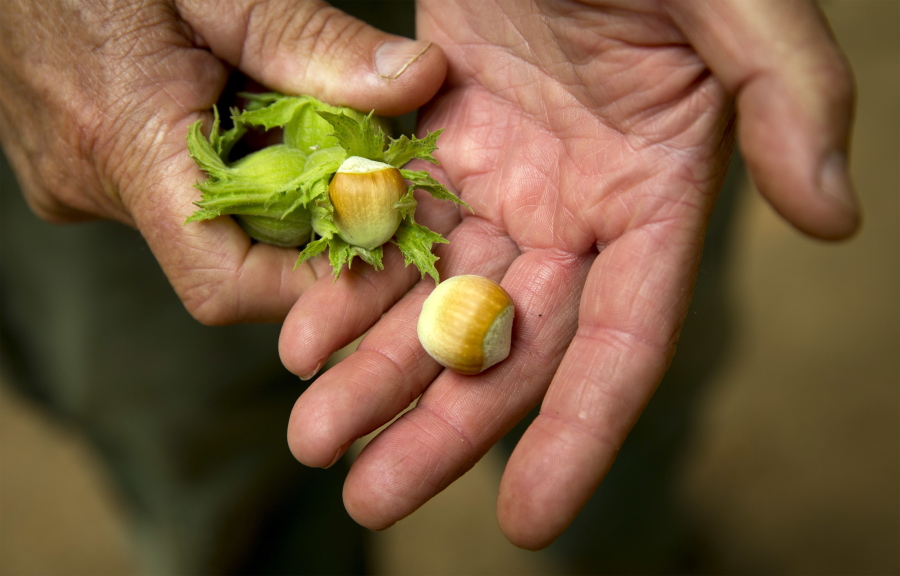EUGENE, Ore. — The hazelnut crop in Oregon is a lot like a roller coaster: up one year and down the next.
Hazelnuts, also called filberts, are a popular ingredient in baked goods, candy and snacks.
Based on field and lab tests, national agricultural experts recently predicted that Oregon will produce 36,000 tons of hazelnuts this year, down 18 percent from 44,000 tons last year.
But hazelnut growers and industry representatives say production always has been hard to predict, and in recent years, it has become even harder.
“There are so many variables that it’s difficult to come up with this number every year,” said Polly Owen, director of the Oregon Hazelnut Industry Office, based in Aurora, south of Wilsonville.
“For us, it’s more of a guideline,” she said. “It’s a predictor. We won’t know (the actual figure) until the crop comes in.”
Garry Rodakowski, who has a 60-acre hazelnut orchard in Vida, near the McKenzie River east of Springfield, said he wasn’t too surprised by this year’s forecast of a smaller crop. Rodakowski is chairman of the Oregon Hazelnut Commission, a commodity commission and state agency under the state Department of Agriculture.
“As I look at my orchard out of the tractor window, I can see the effects of eastern filbert blight, and my trees won’t produce as much as they used to because I’m having to prune that blight out,” he said Wednesday.
Growers are pruning trees to contain eastern filbert blight, a deadly fungus, and some have replaced old, diseased trees with younger disease-resistant varieties.
Earlier this month, experts with the U.S. Department of Agriculture National Agricultural Statistics Service picked a limb with nuts off two trees at 180 orchards in Oregon’s Willamette Valley, said Dave Losh, a statistician with the service’s Oregon field office.
Then nut samples were taken to a regional office where they were measured, weighed, cracked and analyzed to arrive at the 2017 crop estimate.
“We just found there were less nuts per tree, and the nuts were smaller than usual,” Losh said.
“Most of the decline has been (due) to blight, but some has to do with the amount of pruning (by growers) to try to head off the blight,” he said.
Rodakowski said he’s trying to get five more years from his Barcelona variety trees — some of them are 85 years old — before he removes diseased trees and plants new varieties.
But other growers have been quicker to plant new trees, and those new varieties throw new variables into the annual crop forecasts.
“You have an increasing (production) curve for the new varieties and a downward curve for the Barcelona variety,” Rodakowski said. “We don’t know how quickly (the old varieties) are going downhill and how fast (the new varieties) are going uphill.
“We don’t know what the production of 7- to 8-year-old orchards with new varieties is going to be compared to in the past,” he said.
Another big question mark is what price the nuts will fetch after harvest.
Prices are determined by the world market, which is dominated by Turkey.
Oregon produces 99 percent of the U.S. hazelnut crop, but only about 5 percent of the world crop, according to the Oregon Hazelnut Industry Office.
“We’re such a small portion of the world market, but we get a premium because of high quality of Oregon-grown nuts,” Rodakowski said.
Oregon exports about half of its annual crop to markets such as Europe and China.
Rodakowski said he didn’t think the severe ice storms in parts of Oregon, including Lane County, early this year will affect this year’s hazelnut crop.
Some growers in the River Road area of Eugene were hit hard, but most of Oregon’s hazelnut orchards are farther north, Rodakowski said.
Marion County has the highest hazelnut acreage in the state, followed by Yamhill County.
“I think it will be a very good year regardless of the crop size,” said Owen, director of the Oregon Hazelnut Industry Office.
“The demand for hazelnuts worldwide is growing,” she said.
In the U.S., a growing number of products use hazelnuts, from bread to chocolate candy, Owen said.



